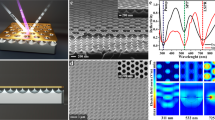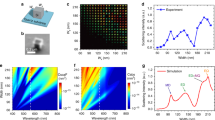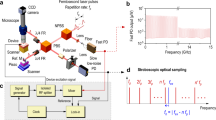Abstract
Mechanical forces induced by high-speed oscillations provide an elegant way to dynamically alter the fundamental properties of materials such as refractive index, absorption coefficient and gain dynamics. Although the precise control of mechanical oscillation has been well developed in the past decades, the notion of dynamic mechanical forces has not been harnessed for developing tunable lasers. Here we demonstrate actively tunable mid-infrared laser action in group-IV nanomechanical oscillators with a compact form factor. A suspended GeSn cantilever nanobeam on a Si substrate is resonantly driven by radio-frequency waves. Electrically controlled mechanical oscillation induces elastic strain that periodically varies with time in the GeSn nanobeam, enabling actively tunable lasing emission at >2 μm wavelengths. By utilizing mechanical resonances in the radio frequency as a driving mechanism, this work presents wide-range mid-infrared tunable lasers with ultralow tuning power consumption.
This is a preview of subscription content, access via your institution
Access options
Access Nature and 54 other Nature Portfolio journals
Get Nature+, our best-value online-access subscription
$29.99 / 30 days
cancel any time
Subscribe to this journal
Receive 12 print issues and online access
$259.00 per year
only $21.58 per issue
Buy this article
- Purchase on Springer Link
- Instant access to full article PDF
Prices may be subject to local taxes which are calculated during checkout




Similar content being viewed by others
Data availability
The data that support the findings of this study are available in this article and its Supplementary Information. Any other relevant data are available from the corresponding authors upon request.
References
Choi, J.-H. et al. A high-resolution strain-gauge nanolaser. Nat. Commun. 7, 11569 (2016).
Niffenegger, R. J. et al. Integrated multi-wavelength control of an ion qubit. Nature 586, 538–542 (2020).
Corato-Zanarella, M. et al. Widely tunable and narrow-linewidth chip-scale lasers from near-ultraviolet to near-infrared wavelengths. Nat. Photon. 17, 157–164 (2023).
Shim, E. et al. Tunable single-mode chip-scale mid-infrared laser. Commun. Phys. 4, 268 (2021).
Xin, M. et al. Optical frequency synthesizer with an integrated erbium tunable laser. Light Sci. Appl. 8, 122 (2019).
Huang, M. C. Y., Zhou, Y. & Chang-Hasnain, C. J. A nanoelectromechanical tunable laser. Nat. Photon. 2, 180–184 (2008).
Snigirev, V. et al. Ultrafast tunable lasers using lithium niobate integrated photonics. Nature 615, 411–417 (2023).
Li, M. et al. Integrated Pockels laser. Nat. Commun. 13, 5344 (2022).
Ueda, Y., Shindo, T., Kanazawa, S., Fujiwara, N. & Ishikawa, M. Electro-optically tunable laser with ultra-low tuning power dissipation and nanosecond-order wavelength switching for coherent networks. Optica 7, 1003–1006 (2020).
Andreou, S., Williams, K. A. & Bente, E. A. J. M. Electro-optic tuning of a monolithically integrated widely tuneable InP laser with free-running and stabilized operation. J. Lightwave Technol. 38, 1887–1894 (2020).
Huang, M. C. Y., Zhou, Y. & Chang-Hasnain, C. J. A surface-emitting laser incorporating a high-index-contrast subwavelength grating. Nat. Photon. 1, 119–122 (2007).
Unterreithmeier, Q. P., Weig, E. M. & Kotthaus, J. P. Universal transduction scheme for nanomechanical systems based on dielectric forces. Nature 458, 1001–1004 (2009).
Liu, N. et al. Time-domain control of ultrahigh-frequency nanomechanical systems. Nat. Nanotechnol. 3, 715–719 (2008).
Li, M., Tang, H. X. & Roukes, M. L. Ultra-sensitive NEMS-based cantilevers for sensing, scanned probe and very high-frequency applications. Nat. Nanotechnol. 2, 114–120 (2007).
Henry Huang, X. M., Zorman, C. A., Mehregany, M. & Roukes, M. L. Nanodevice motion at microwave frequencies. Nature 421, 496–496 (2003).
Gupta, S., Magyari-Köpe, B., Nishi, Y. & Saraswat, K. C. Achieving direct band gap in germanium through integration of Sn alloying and external strain. J. Appl. Phys. 113, 073707 (2013).
Burt, D. et al. Direct bandgap GeSn nanowires enabled with ultrahigh tension from harnessing intrinsic compressive strain. Appl. Phys. Lett. 120, 202103 (2022).
Burt, D. et al. Strain-relaxed GeSn-on-insulator (GeSnOI) microdisks. Opt. Express 29, 28959–28967 (2021).
Dutt, B. et al. Theoretical analysis of GeSn alloys as a gain medium for a Si-compatible laser. IEEE J. Sel. Topics Quantum Electron. 19, 1502706 (2013).
Nam, D. et al. Strain-induced pseudoheterostructure nanowires confining carriers at room temperature with nanoscale-tunable band profiles. Nano Lett. 13, 3118–3123 (2013).
Joo, H.-J. et al. 1D photonic crystal direct bandgap GeSn-on-insulator laser. Appl. Phys. Lett. 119, 201101 (2021).
Cleland, A. N. & Roukes, M. L. Noise processes in nanomechanical resonators. J. Appl. Phys. 92, 2758–2769 (2002).
Liu, J. et al. Ultrafast detection of terahertz radiation with miniaturized optomechanical resonator driven by dielectric driving force. ACS Photonics 9, 1541–1546 (2022).
Tran, H. et al. Systematic study of Ge1−xSnx absorption coefficient and refractive index for the device applications of Si-based optoelectronics. J. Appl. Phys. 119, 103106 (2016).
Brian Sia, J. X. et al. Sub-kHz linewidth, hybrid III-V/silicon wavelength-tunable laser diode operating at the application-rich 1647-1690 nm. Opt. Express 28, 25215–25224 (2020).
Chu, T., Fujioka, N. & Ishizaka, M. Compact, lower-power-consumption wavelength tunable laser fabricated with silicon photonic wire waveguide micro-ring resonators. Opt. Express 17, 14063–14068 (2009).
Huang, M. C. Y., Zhou, Y. & Chang-Hasnain, C. J. Nano electro-mechanical optoelectronic tunable VCSEL. Opt. Express 15, 1222–1227 (2007).
Beccari, A. et al. Strained crystalline nanomechanical resonators with quality factors above 10 billion. Nat. Phys. 18, 436–441 (2022).
Yu, D. & Vollmer, F. Active optomechanics. Commun. Phys. 5, 61 (2022).
Czerniuk, T. et al. Lasing from active optomechanical resonators. Nat. Commun. 5, 4038 (2014).
Lyubarov, M. et al. Amplified emission and lasing in photonic time crystals. Science 377, 425–428 (2022).
Gaidarzhy, A., Zolfagharkhani, G., Badzey, R. L. & Mohanty, P. Spectral response of a gigahertz-range nanomechanical oscillator. Appl. Phys. Lett. 86, 254103 (2005).
Acknowledgements
This work is supported by the National Research Foundation of Singapore through the NRF-ANR Joint Grant (NRF2018-NRF-ANR009 TIGER). This work is also supported by the National Research Foundation of Singapore through the Competitive Research Program (NRF-CRP19-2017-01). This work is also supported by the iGrant of Singapore A*STAR AME IRG (A2083c0053). This research is also supported by the National Research Foundation, Singapore, and A*STAR under its Quantum Engineering Programme (NRF2022-QEP2-02-P13), by ANR-18-CE24-0025 project TIGER and the ENS-Thales Chair. We acknowledge and thank the Nanyang NanoFabrication Centre (N2FC). We also thank D. Zhu, J. Witzens and B. Marzban for fruitful discussions.
Author information
Authors and Affiliations
Contributions
D.N., C.S. and Y.T. conceived the initial idea of the project. H.-J.J. fabricated the samples. H.-J.J. and D.N. planned the optical experiments. H.-J.J. and M.C. carried out the optical measurements. J.L. and B.C. conducted the optomechanical simulations and characterization measurements. D.G. assisted with the mechanical measurement setup. J.L., Y.T. and A.V. conducted theoretical studies on driven nanomechanical oscillators. Under the guidance of D.N., Y.T. and C.S., H.-J.J. and J.L. performed the data analysis. Y.K. optimized the laser structure by performing optical simulations. Z.I. conducted the band structure simulations and gain modelling. K.L. and X.S. assisted with the optical measurement setup. Y.-I.S. contributed to the construction of the RF drive setup. L.Z. and C.S.T. prepared the GeSn wafer. D.B. fabricated the GeSnOI substrates. H.-J.J. and D.N. led the manuscript writing with input from J.L., M.C., D.B., C.S. and Y.T. All authors discussed the data and participated in preparing the manuscript.
Corresponding authors
Ethics declarations
Competing interests
The authors declare no competing interests.
Peer review
Peer review information
Nature Nanotechnology thanks the anonymous reviewers for their contribution to the peer review of this work.
Additional information
Publisher’s note Springer Nature remains neutral with regard to jurisdictional claims in published maps and institutional affiliations.
Supplementary information
Supplementary Information
Supplementary Notes 1–12, Figs. 1–15 and Table 1.
Rights and permissions
Springer Nature or its licensor (e.g. a society or other partner) holds exclusive rights to this article under a publishing agreement with the author(s) or other rightsholder(s); author self-archiving of the accepted manuscript version of this article is solely governed by the terms of such publishing agreement and applicable law.
About this article
Cite this article
Joo, HJ., Liu, J., Chen, M. et al. Actively tunable laser action in GeSn nanomechanical oscillators. Nat. Nanotechnol. (2024). https://doi.org/10.1038/s41565-024-01662-w
Received:
Accepted:
Published:
DOI: https://doi.org/10.1038/s41565-024-01662-w



